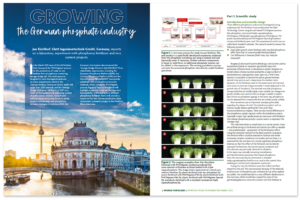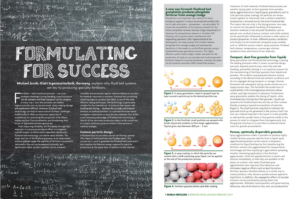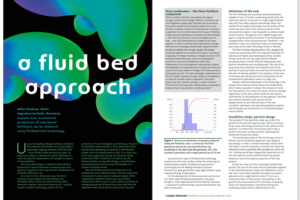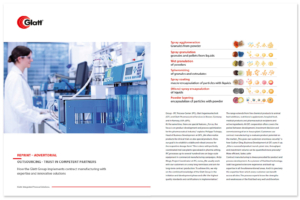Improved performance for crop protection products
Plant protection products, be they herbicides or fungicides, must be dust-free, free-flowing, stable, safe to handle and provide good redispersibility properties. In the future, it will also be important to tailor their effectiveness to deal with particular hazards or pests, and increase tolerance to extreme weather conditions.
- Author: Dr. Michael Jacob, Head of Process Technology Food, Feed & Fine Chemicals, Glatt Ingenieurtechnik GmbH
- originally published in the Speciality Chemicals Magazine, September 2019 issue, (TRMG Ltd., UK)
- Speciality Chemicals Magazine Sept-Oct 2019 (zmags.com)
Product development usually focuses on the optimization of successful products: That means improved effectiveness and storage, safer handling and easier dosing. As well as these long-standing challenges, however, farmers and manufacturers of crop protection products are facing an increasingly fragmented market with regionally specific requirements. Due to globalisation and imbalances in the ecosystem, it is becoming increasingly necessary to control pests in a targeted manner and protect plants from previously unknown threats. Yet a growing market for organic farming means an increase in demand for biological or biodegradable crop protection agents which are obtained, for example, by fermentation processes. Industrial processing means these intermediate products are not temperature-stable and require gentle treatment at low temperatures. A further challenge is climate change: Cultivated areas in normally temperate climate regions are now exposed to weather events such as heavy rainfall or prolonged periods of drought with extreme temperatures. Wetness and hot and cold spells make it increasingly difficult to control soil conditions, plant growth and harvest times. These extremes can also lead to plants being threatened by incalculable influences, so while there is a need for action to ensure crops thrive, preventive plant protection and pest control is also necessary.
Gentle processes for sensitive substances
Glatt Ingenieurtechnik, the German expert in particle design, process development and plant engineering, offers unique possibilities for all these fields of activity with fluid bed and spouted bed technologies: By means of spray granulation, spray agglomeration, spray coating or (micro)spray encapsulation, the properties and functionality of different raw materials and also multicomponent systems for new formulations can be optimized. This not only improves solubility, but also ensures that ingredients are homogeneously distributed in particles with a broad, specifically adjustable size spectrum. Compared to classic spray drying, it’s possible to work at very low temperatures with short processing times, and thermal damage can be avoided at product temperatures under 70 degrees Celsius. This can be achieved, for example, with a maximum inflow temperature of up to 150 degrees, which is economical and yet safe. Accordingly, the planning of the plants requires extensive engineering competence including risk assessment, specific plant design and initiation of concepts that make for safe process control.
In addition, functionalized substances can be dosed more effectively and safely. They are also more stable in storage and can be color-matched to the product design. A functionalized surface ensures tailor-made application properties. Redispersibility, release behavior and homogeneity are just some of the parameters to ensure optimum effectiveness with minimum use of raw materials. What is usually important with crop protection products is the formulation of the liquid suspension, which contains insoluble components such as salts, ashes or metal complexes, or carrier materials, which must be mixed carefully with each other under strict safety precautions.
Technology: fluidized bed and spouted bed
The almost unlimited possibilities of process design are provided by the unique flow-mechanical and thermodynamic properties that allow for groundbreaking processes for optimizing powders and liquids, and refining them almost without restriction (Table 1). Both concepts make it possible to thermally dry and functionalize raw materials economically in a single process step – batchwise or continuously, in single-stage or multi-stage processes, under protective gas as well as nitrogen. Drying and product design are thus possible in one process step using the same apparatus (Fig. 1).
A fluidized bed is created when upwardly flowing process air lifts a layer of solid particles, thus fluidizing them. The process air is used to generate the fluidized bed state. At the same time, it supplies the thermal energy required for the particle technology processes. In addition to the thermal treatment of solids, fluidized bed processes are used for drying tasks, the construction of granulates from powders (spray agglomeration) or from liquids (spray granulation) and the coating of particles (spray coating). In the fluidized bed, the particles behave in principle like a liquid. All particles are mixed so intensively that a uniform treatment temperature is guaranteed in the entire fluidized bed. The spouted bed technology is also based on the basic principle of fluidizing particles by upwardly flowing process air. The difference between the concepts lies in the fluid mechanics and process dynamics. This results in significantly higher heat and mass transfer rates for the processing of sensitive products with short residence times.
Compact, dust-free, water-soluble granulates
Spray granulation is an optimal process for the production of granules from liquids and powders. The round pellets provide a dense surface and high abrasion resistance. The granules are built up and then dried in a single process step: liquids are sprayed onto fluidized particles, and then dry on the surface (Fig. 2). This results in layered particle growth. The small particles required for further granulate build-up are generated in the process itself. Only the liquid raw material – classically a suspension – has to be provided. In addition, it is possible to feed powdery or fine-particle solids into the process in a targeted manner in order either to integrate them homogeneously into the granulate structure, or to use them as external starting cores for granulate growth.
The practical advantages also include improved shelf life due to reduced hygroscopicity, and better transport and dosing properties. At the same time, the water solubility of the granules can be specifically adjusted for liquefying it again before spreading. Another interesting application is fine agglomerates, which are applied directly to plants and dissolve immediately, becoming active on contact with water (Fig. 3).
Microencapsulation is based on the spray granulation process and therefore supplies granules of solid or liquid substances which are particularly sensitive or volatile. They can be homogeneously distributed and embedded in a protective matrix – an ideal solution to stabilize active substances and also enable the loading of porous granulates with solid auxiliary materials.
High degree of flexibility
Structure granulation – so-called “layering” – enables a high degree of flexibility, as particles are formed from different solid layers, and cores can be loaded and coated. This offers manufacturers the opportunity to functionalize their products in a targeted manner, and equip them with a higher added value – which ultimately determines market success. In addition, the same apparatus can be used to coat the previously spray granulated particles, for example to achieve a retarding effect, to protect the active component from external influences or to mask an unpleasant taste or odor, which might be interesting when producing feed and also pesticides that must suit the pest.
Spray granulation vs. spray drying
Continuously operated spray granulation processes offer impressive flexibility due to the process chamber design – for example, subsequent cooling can be combined in the same apparatus. In addition, fluidized bed spray granulation systems for handling organic solvents or oxidation-sensitive products can be easily implemented in a closed loop operation. An essential difference between spray drying and fluidized bed spray granulation lies in the particle size and morphology: In spray drying, the individual particles are dried from the outside to the inside, whereas in spray granulation, the particles are built up in layers and dried the other way round – from the inside out. As soon as the liquid contains a dissolved component, the spray drying process produces a wide variety of hollow spheres. The hot air stream in which the spray droplets are dried causes a hard outer shell of the single particle with a high concentration of the dissolved component, while the inner core of the particle still contains moisture. As the temperature increases, the moisture suddenly escapes and, depending on the drying speed and solids concentration of the liquid, causes hollow spheres or dents in the particles. Only when spraying melts and pure suspensions do solid spheres form during spray drying. In certain fields of application, such as microencapsulation of active ingredients, these particle properties are unsuitable, however, since the aim of microencapsulation is to enclose liquids in the core of the particles and protect them from environmental conditions.
Further information on this topic and related topics can also be found in the following publications:
Published article: ‘Growing the German phosphate industry’. PDF, English
Published article: ‘Like a phoenix from the ashes’. A recovery technology that releases phosphate from sewage sludge ashes and converts it into ready-to-use fertilizers. PDF, English
Published article: ‘Fomulation For Success – Fluid Bed Systemes as Key for the Production of Speciality Fertilizers’, PDF, English
Published article: ‘A Fluid Bed Approach – Case study on the economical production of urea-based fertilizers can be achieved using fluidised bed technology’ PDF, English
Published article: ‘Outsourcing – Trust in competent partners’ PDF, English







 Copyright: Wiley-VCH Verlag GmbH & Co. KGaA
Copyright: Wiley-VCH Verlag GmbH & Co. KGaA Copyright: Glatt
Copyright: Glatt